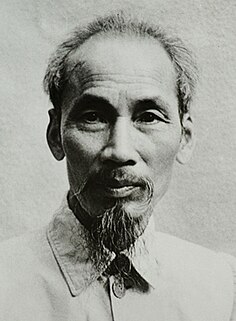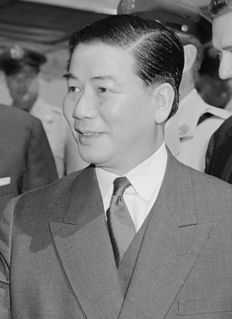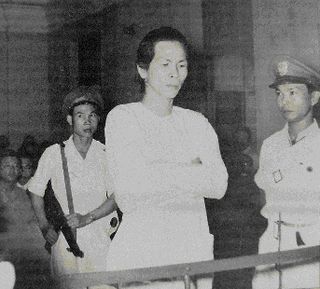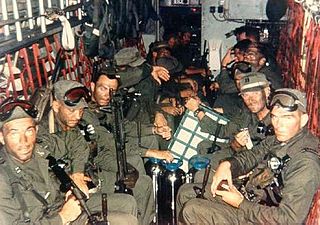 W
W1940—1946 in French Indochina focuses on events that happened in French Indochina during and after World War II and which influenced the eventual decision for military intervention by the United States in the Vietnam War. French Indochina in the 1940s was divided into five protectorates: Cambodia, Laos, Tonkin, Annam, and Cochinchina. The latter three made up Vietnam. In 1940, the French controlled 23 million Vietnamese with 12,000 French soldiers, about 40,000 Vietnamese soldiers, and the Sûreté, a powerful police force. At that time, the U.S. had little interest in Vietnam or French Indochina as a whole. Fewer than 100 Americans, mostly missionaries, lived in Vietnam and U.S. government representation consisted of one consul resident in Saigon.
 W
W1947–1950 in French Indochina focuses on events influencing the eventual decision for military intervention by the United States in the First Indochina War. In 1947, France still ruled Indochina as a colonial power, conceding little real political power to Vietnamese nationalists. French Indochina was divided into five protectorates: Cambodia, Laos, Tonkin, Annam, and Cochinchina. The latter three made up Vietnam.
 W
WWhen 1954 began, the French had been fighting the insurgent communist-dominated Viet Minh for more than seven years attempting to retain control of their colony Vietnam. Domestic support for the war by the population of France had declined. The United States was concerned and worried that a French military defeat in Vietnam would result in the spread of communism to all the countries of Southeast Asia—the domino theory—and was looking for means of aiding the French without committing American troops to the war.
 W
WIn 1955, the Prime Minister of South Vietnam Ngô Đình Diệm faced a severe challenge to his rule over South Vietnam from the Bình Xuyên criminal gang and the Cao Đài and Hòa Hảo religious sects. In the Battle of Saigon in April, Diệm's army eliminated the Bình Xuyên as a rival and soon also reduced the power of the sects. The United States, which had been wavering in its support of Diệm before the battle, strongly supported him afterwards. Diệm declined to enter into talks with North Vietnam concerning an election in 1956 to unify the country. Diệm called a national election in October and easily defeated Head of State Bảo Đại, thus becoming President of South Vietnam.
 W
WNgo Dinh Diem consolidated his power as the President of South Vietnam. He declined to have a national election to unify the country as called for in the Geneva Accords. In North Vietnam Ho Chi Minh apologized for certain consequences of the land reform program he had initiated in 1955. The several thousand Viet Minh cadres the North had left behind in South Vietnam focused on political action rather than insurgency. The South Vietnamese army attempted to root out the Viet Minh.
 W
WIn 1957 South Vietnam's President Ngô Đình Diệm visited the United States and was acclaimed a "miracle man' who had saved one-half of Vietnam from communism. However, in the latter part of the year, violent incidents committed by anti-Diệm insurgents increased and doubts about the viability of Diệm's government were expressed in the media and by U.S. government officials.
 W
WIn 1958, the upswing in violence against the government of South Vietnam continued, much of which was committed by the communist-dominated insurgents now called the Viet Cong. In South Vietnam, President Ngo Dinh Diem appeared to be firmly in power, although many American officials expressed concern about the repressive nature of his regime. The United States continued to finance most of the budget of the government of South Vietnam. North Vietnam continued to campaign for reunification with the South while focusing on its internal economic development, but pressure from hard-pressed communists in the South was forcing the North to contemplate a more active military role in overthrowing the Diem government.
 W
W1959 saw Vietnam still divided into South and North. North Vietnam authorized the Viet Cong (VC)to undertake limited military action as well as political action to subvert the Diệm government. North Vietnam also authorized the construction of what would become known as the Ho Chi Minh Trail to supply the VC in South Vietnam. Armed encounters between the VC and the government of South Vietnam became more frequent and with larger numbers involved. In September, 360 soldiers of the Army of the Republic of Vietnam (ARVN) were ambushed by a force of about 100 VC guerrillas.
 W
WIn 1960, the oft-expressed optimism of the United States and the Government of South Vietnam that the Viet Cong (VC) were nearly defeated proved mistaken. Instead the VC became a growing threat and security forces attempted to cope with VC attacks, assassinations of local officials, and efforts to control villages and rural areas. Throughout the year, the U.S. struggled with the reality that much of the training it had provided to the Army of the Republic of Vietnam (ARVN) during the previous five years had not been relevant to combating an insurgency. The U.S. changed its policy to allow the Military Assistance Advisory Group (MAAG) to begin providing anti-guerrilla training to ARVN and the paramilitary Civil Guard.
 W
WThe year 1961 saw a new American president, John F. Kennedy, attempt to cope with a deteriorating military and political situation in South Vietnam. The Viet Cong (VC) with assistance from North Vietnam made substantial gains in controlling much of the rural population of South Vietnam. Kennedy expanded military aid to the government of President Ngô Đình Diệm, increased the number of U.S. military advisors in South Vietnam, and reduced the pressure that had been exerted on Diệm during the Eisenhower Administration to reform his government and broaden his political base.
 W
WThe Viet Cong (VC) insurgency expanded in South Vietnam in 1962. U.S. military personnel flew combat missions and accompanied South Vietnamese soldiers in ground operations to find and defeat the insurgents. Secrecy was the official U.S. policy concerning the extent of U.S. military involvement in South Vietnam. The commander of Military Assistance Command, Vietnam (MACV), General Paul D. Harkins, projected optimism that progress was being made in the war, but that optimism was refuted by the concerns expressed by a large number of more junior officers and civilians. Several prominent magazines, newspapers and politicians in the U.S. questioned the military strategy the U.S. was pursuing in support of the South Vietnamese government of President Ngô Đình Diệm. Diệm created the Strategic Hamlet Program as his top priority to defeat the VC. The program intended to cluster South Vietnam's rural dwellers into defended villages where they would be provided with government social services.
 W
WThe defeat of the South Vietnamese Army of the Republic of Vietnam (ARVN) in a battle in January set off a furious debate in the United States on the progress being made in the war against the Viet Cong (VC) in South Vietnam. Assessments of the war flowing into the higher levels of the U.S. government in Washington, D.C. were wildly inconsistent, some citing an early victory over the VC, others a rapidly deteriorating military situation. Some senior U.S. military officers and White House officials were optimistic; civilians of the Department of State and the Central Intelligence Agency (CIA), junior military officers, and the media were decidedly less so. Near the end of the year, U.S. leaders became more pessimistic about progress in the war.
 W
WSouth Vietnam was in political chaos during much of the year, as generals competed for power and Buddhists protested against the government. The Viet Cong (VC) communist guerrillas expanded their operations and defeated the South Vietnamese Army of the Republic of Vietnam (ARVN) in many battles. North Vietnam made a definitive judgement in January to assist the VC insurgency with men and material. In November, North Vietnam ordered the People's Army of Vietnam (PAVN) to infiltrate units into South Vietnam and undertake joint military operations with the VC.
 W
WIn 1965, the United States rapidly increased its military forces in South Vietnam, prompted by the realization that the South Vietnamese government was losing the Vietnam War as the communist-dominated Viet Cong (VC) gained influence over much of the population in rural areas of the country. North Vietnam also rapidly increased its infiltration of men and supplies to combat South Vietnam and the U.S.. The objective of the U.S. and South Vietnam was to prevent a communist take-over. North Vietnam and the VC sought to unite the two sections of the country.
 W
WAt the beginning of 1966, the number of U.S. military personnel in South Vietnam totaled 184,314. South Vietnamese military forces totaled 514,000 including the army (ARVN) and the Regional Force and Popular Force militias. The North Vietnamese People's Army of Vietnam (PAVN) numbered 400,000, most still in North Vietnam. 50,000 PAVN cadre and soldiers infiltrated South Vietnam during 1965. Group 559, charged with transporting supplies down the Ho Chi Minh Trail to supply PAVN troops in both South Vietnam and Laos, numbered 24,400 personnel. The U.S. estimated the number of Viet Cong (VC) and PAVN soldiers in South Vietnam at nearly 280,000 by June 1966, including part-time guerrillas. A pause in the bombing of North Vietnam by U.S. warplanes had been announced by President Johnson on 24 December and remained in effect.
 W
WAt the beginning of 1967 the United States was engaged in a steadily expanding air and ground war in Southeast Asia. Since its inception in February 1965, Operation Rolling Thunder, the bombing campaign against North Vietnam, had escalated in the number and significance of its targets, inflicting major damage on transportation networks industry, and petroleum refining and storage facilities. Yet the campaign showed no signs of achieving either of its stated objectives. The air attacks had not broken the Hanoi government’s will to continue the war, and they had not halted or appreciably hindered the flow of People's Army of Vietnam (PAVN) troops and supplies into South Vietnam. North Vietnam had been able to repair damage and develop substitutes for destroyed facilities rapidly enough to counter the incremental escalation of the U.S. air campaign. With Soviet and Chinese assistance, the North Vietnamese had built a large and sophisticated air defense system. Its guns and missiles extracted a toll in pilots and aircraft for every American raid. On the ground in South Vietnam, the U.S. force buildup, begun in late 1965, was approaching completion. More than 380,000 American troops were in the country, alongside over 730,000 Army of the Republic of Vietnam (ARVN) soldiers and some 52,000 soldiers from other allied nations. After a year of base building and intensifying combat, the U.S. commander, General William Westmoreland, believed that his forces were ready for major offensives that would seize the battlefield initiative from the PAVN and Viet Cong (VC). The PAVN/VC, however, had been conducting their own buildup, including the infiltration into South Vietnam of regular PAVN divisions. These units, along with VC guerrillas and light infantry formations, were countering the American challenge. Within South Vietnam, the PAVN/VC sought opportunities to inflict American casualties in large and small engagements. They also concentrated troops at various points on South Vietnam’s borders to create a strategic threat to the allies and compel the Military Assistance Command, Vietnam, (MACV) to disperse its reserves.
 W
WThe year 1968 saw major developments in the Vietnam War. The military operations started with an attack on a US base by the North Vietnamese People's Army of Vietnam (PAVN) and the Viet Cong (VC) on January 1, ending a truce declared by the Pope and agreed upon by all sides. At the end of January, the PAVN and VC launched the Tet Offensive.
 W
W W
W W
W W
W1973 in the Vietnam War began with a peace agreement, the Paris Peace Accords, signed by the United States and South Vietnam on one side of the Vietnam War and communist North Vietnam and the insurgent Viet Cong on the other. Although honored in some respects, the peace agreement was violated by both North and South Vietnam as the struggle for power and control of territory in South Vietnam continued. North Vietnam released all American prisoners of war and the United States completed its military withdrawal from South Vietnam.
 W
W1975 marked the end of the Vietnam War, sometimes called the Second Indochina War or the American War. The North Vietnamese People's Army of Vietnam (PAVN) launched the Spring Offensive in March; the South Vietnamese Army of the Republic of Vietnam (ARVN) was quickly defeated. The North Vietnamese captured Saigon on April 30, accepting the surrender of South Vietnam. In the final days of the war, the United States, which had supported South Vietnam for many years, carried out an emergency evacuation of its civilian and military personnel and more than 130,000 Vietnamese.